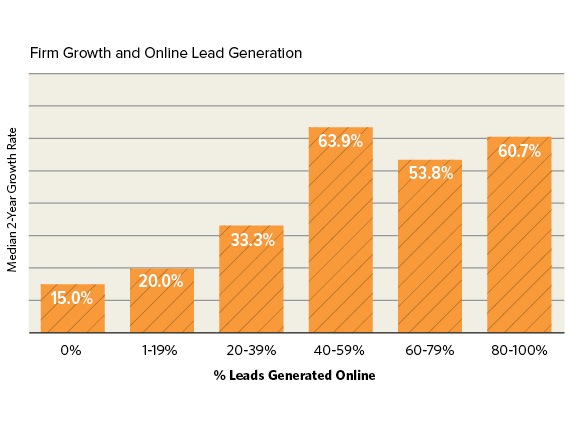As the end of the year approaches, many professional services firms will ask “what is the return on investment for my marketing expenditures?”
However, the ROI for traditional marketing investments is notoriously difficult to measure. Because of this, it seems like marketing expenses are the first to be cut when budgets are being evaluated.
In contrast, online marketing offers opportunities for measurement above and beyond traditional measurement. You can track prospect interaction and engagement down to individual clicks and page views thanks to tools like Google Analytics, Google Webmaster Tools, and social media monitoring software.
So with all these tools at hand, how do you most effectively track the ROI of online marketing? And how does online marketing help your firm in the first place? It starts with content.
Lead generation through content
Our research shows that 77% of professional firms generate new business leads online. And firms that generate at least 40% of their leads online are positioned to become two times more profitable than those who don’t. Impressive, right?

With such high success rates, it might seem like online marketing should cost more than traditional marketing – but the opposite is often true.
On a whole, online lead generation efforts are less expensive than traditional marketing approaches, like in-person networking events or print advertisements.
But before the leads come in the door, how do you know if your online marketing is gaining traction? Here are four performance indicators that can help you calculate the ROI.
4 Key Performance Indicators of a B2B Online Marketing Campaign
1. Content downloads. Most users are willing to provide personal information (i.e. name and email address) in exchange for substantial pieces of content like guides, books, and long-form articles. When users provide this information, they are considered a “conversion” and move further along the content funnel, closer to becoming a hot lead.
Each user who downloads a piece of content indicates return on your content marketing investment. To track conversions, you can set up goals in Google Analytics for each piece of downloadable content on your website.

2. Followers and engagement on social media. Your social media platforms allow you to share your content with a wide audience who cares about your content and brand. By acquiring more followers or subscribers, you increase your reach and the potential for your content to be shared.
Increasing your number of followers is a good indicator that the content you’re producing is valuable to your audience. When prospects choose to follow your firm on social media, they are demonstrating that what you share is important to them.
Beyond the number of followers, social engagement is another important metric to look at. How many times is your content re-tweeted? How many people “like” and “share” your Facebook posts? How many impressions do your LinkedIn updates have? Keeping track of these metrics is the only way to know if your social media efforts are making an impact.
SEE ALSO: The Top 10 Advantages of Online Marketing in Professional Services
3. Opt-ins to your email list or newsletter. When prospects choose to sign up for your email list or to receive your newsletter, they’re indicating an increased commitment and interest in your content. Their email inbox is a personal space and they’re making the choice to receive your content directly.
Growing an email list does not happen overnight. Research shows that 50% of organizations describe their email list growth as positive, but slow. Only 17% of respondents say their email list is growing rapidly.
Creating and expanding an email database can be a slow, painful process, but one of the most critical ones to grow and nurture an audience of potential leads.
4. Increased sales. When it comes right down to it, the ultimate performance indicator that your online marketing is working is an increase in your number of leads and closed business opportunities. When these numbers are trending upwards, this shows that your content resonates with the right audiences, your firm is visible in the marketplace, and your firm has educated prospects on the services you offer.
Our research shows that it’s the highest growing professional services firms who are taking advantage of lead generation through online marketing. While average growth firms generate 12% of their leads online, high growth firms generate over 62% of their new business leads on the web.

Using b2b online marketing to generate more leads can help increase the growth of your firm without breaking the budget. By tracking these four performance indicators when calcuating ROI, you’ll be able to ensure online marketing is a strategic and worthwhile investment for your firm.
Ready to learn more? Download the free ebook Online Marketing for Professional Services below.
On Google+ or LinkedIn? Follow us +HingeMarketing and join us on LinkedIn.

